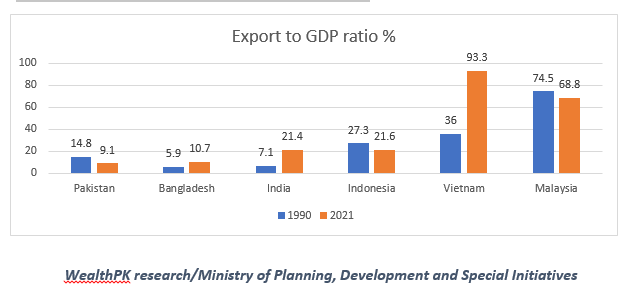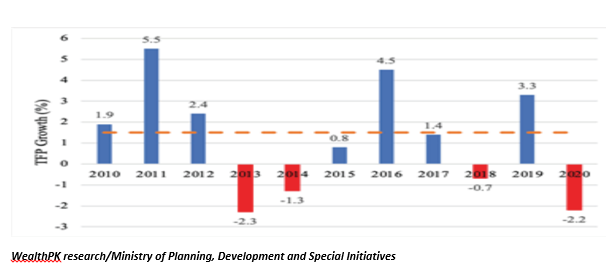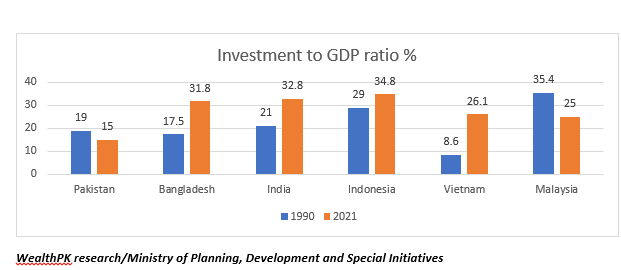INP-WealthPk
Arsalan Ali
Pakistan’s export-to-GDP ratio is worryingly low compared to its regional rivals who are thriving in global trade. To boost its export and pave the way for sustainable economic growth, Pakistan needs a strategy that includes:market diversification, augmented productivity, streamlined trade facilitation, robust brand development, conducive business environment, and nurturing of small and medium enterprises (SMEs), according to a report published by the Ministry of Planning, Development, and Special Initiatives.

The report said the primary focus of Pakistan's major exports lies in the textile sector, which has played a significant role in bolstering the country's external sector inflows. However, it is imperative to foster the development of new avenues for export growth, utilising local resources and capabilities. According to data provided by the Pakistan Bureau of Statistics (PBS), the total exports of Pakistan during the initial 11 months (July-May) of the fiscal year 2022-23 amounted to $25.3805 billion. Among the export categories, textiles accounted for 59.2%, food group 18.3%, other manufactured goods 13.8%, petroleum and coal 0.8%, and all other items constituted a share of 7.7%. The report said it is important to create new types of products that can be exported, diversifying the sources of income from exports.
It would also be beneficial for the economy to improve access to larger global markets where Pakistani products have a competitive edge. According to the Trade Development Authority of Pakistan (TDAP), the country's exports are currently focused on a small number of key markets, including the United States, the European Union, the United Kingdom, and China. These destinations combined make up nearly 60% of Pakistan's total exports. It added that Pakistan should place greater emphasis on enhancing productivity to boost its exports. Global research indicates that countries with total factor productivity (TFP) growth exceeding 3% have experienced GDP growth rates of 8% or more. Conversely, lower TFP growth rates are linked to lower GDP growth rates. In the case of Pakistan, TFP growth has averaged 1.5%, indicating the need for improvements in production, productivity, and technological capabilities to enhance export potential.

The report pointed out that the investment landscape in Pakistan has shown a concerning trend over the past three decades, with a decline in the investment-to-GDP ratio. In contrast, many other countries in the region have experienced significant increases in their investment ratios. While there may be various reasons contributing to this decline, one notable factor is the increasing difficulty of doing business in Pakistan over the years, which has resulted in a lack of investment in the economy.

In addition, although the large-scale manufacturing (LSM) sector has played a role in boosting exports, the small and medium enterprises (SMEs) sector is a crucial driver not only for exports, but also for employment generation. According to Small and Medium Enterprises Development Authority (SMEDA), in Pakistan, the number of SMEs exceeds 5.2 million. These SMEs make up approximately 40% of the country's GDP and contribute around 25% to the overall export volume. Furthermore, they employ a significant portion of the non-agricultural labour force, accounting for approximately 72% of the total.
The report stated that the government aims to support the integration of the SMEs sector into both local export supply chains and global value chains. To achieve this goal, cluster development will be a highly effective approach, particularly for sectors with significant export potential. Additionally, the report said, the government will address challenges related to access to credit and inclusiveness. Priority will be given to nurturing sectors that not only exhibit high export potential, but also align with local resources and strengths, such as capacity, established supply chains, knowledge, and natural resources. The report said exports, foreign direct investment (FDI), and remittances represent three significant channels that hold the potential to alleviate a country's economic challenges.
Credit: INP-WealthPk



